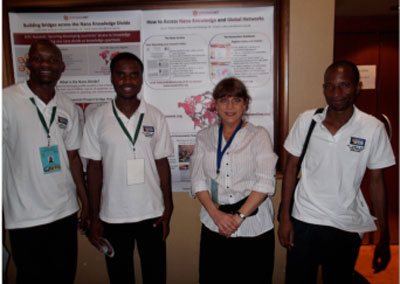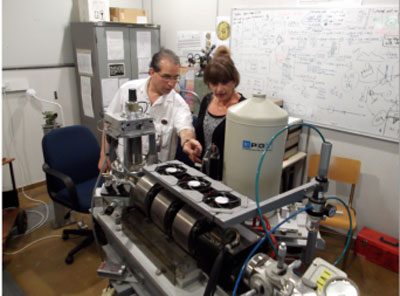| Jan 13, 2012 |
Discovering the materials world of Africa
|
|
(Nanowerk News) As the guest of the African Materials Research Society and NanoSciences Africa Network (NanoAfNet), the Institute of Nanotechnology (UK) has had an invaluable opportunity to gain substantial insight into the latest developments in materials research and applications in Africa. During a dynamic ten-day visit, the Institute was able to gather vital data for the forthcoming region report on Nanoscience and Nanotechnology in Africa, one of eight region reports to be published online in March as part of the EC-funded international networking ICPC Nanonet Project.
|
|
Networking and research activities began at the 6th African Materials Research Society Conference against the stunning backdrop of the Victoria Falls, Zimbabwe. The week-long biennial event attracted well over 300 participants from Africa, Europe, the US and Asia, including a large body of students, and engaged them in talks and seminars examining current and emerging trends in materials research.
|
|
At the opening ceremony, Zimbabwe's Deputy Prime Minister Professor Arthur Mutambara emphasised that science and technology were fundamental to economic growth, adding that scientists and science play a role in determining government choices. He emphasised that the loss of revenue resulting from exportation of unprocessed ore, and particularly the platinum group of minerals, must be prevented.
|
|
Zimbabwe Council for Higher Education (ZIMCHE) chairman Professor Christopher Chetsanga, agreed, urging local scientists to actively seek ways of adding value to Zimbabwe's minerals. The issue of funding was addressed by AMRS president Josephat Zimba, who stated that funding for science and research could lead to enormous benefits for the continent. The region's potential as a top exporter of energy through harvesting, storing and selling solar power overseas was also highlighted.
|
|
Alongside full day workshops on energy materials and crystallography, up to five parallel sessions of talks and seminars ran simultaneously, during which expert speakers explored the symposia themes of Materials for Energy and Sustainability; Materials for Life, Health and the Environment; Basic Materials and NanoScience; Materials Technology, Processing and Metallurgy; Infrastructure Materials; and Materials Education and Networking. Participants commented on the exceptionally high standard of the presentations.
|
 |
| Institute of Nanotechnology/ICPC Nanonet poster presentation at the 6th AMRS Conference, Zimbabwe.
|
|
During the Bi-Annual General Meeting, the closing comments by Prof Aboubaker Beye, Secretary General and Prof Wole Soboyejo, both member of the Executive Board of Africa-MRS focussed on the announcement that the next (7th) Africa MRS Biennial Conference would be held in Addis Ababa in late 2013 or early 2014. It was also announced that Prof. Mona Marei (Alexandria University, Egypt) would be the next President of the Society, that Prof. Teketel Yohannes Anshebo (Addis Ababa University, Ethiopia) would be the next Conference Chair, and that Prof. Eric Garfunkel (Rutgers, USA) would continue as International Advisor.
|
|
Following on from the conference, a subsequent visit to iThemba LABS, South Africa as the guest of Prof Malik Maaza, chair of NanoScience Africa Network (NanoAfNet), provided invaluable insight into cutting edge research and development taking place at its Western Cape base.
|
|
The iThemba Laboratory for Accelerator-Based Sciences is a group of multi-disciplinary research laboratories administered by the National Research Foundation. The Western Cape site accommodates a Cyclotron Accelerator Building, Radiotherapy Vaults, and laboratories engaged in Isotype Production, Medical Physics, Nuclear Medicine and Radiobiology. The importance of iThemba is demonstrated by the fact that it is currently producing 25% of the world's Strontium and 100% of the NA22 isotope.
|
 |
| Prof Malik Maaza providing an overview of the PIXE to Lesley Tobin of the Institute of Nanotechnology (UK) at iThemba LABS, Western Cape.
|
|
The Materials Research Group building, the oldest in the complex, holds iThemba's Van de Graaff Accelerator, responsible for the synthesisation and characterisation of materials. Through the acceleration of protons different reactions are produced that can then be applied to detect the tiniest amounts of plastic explosive, for example, while another section of the accelerator is developing sensors for hydrogen fuel, vital for the new generation of hydrogen fuelled cars. An additional unit allows for elemental analysis and the characterisation of materials.
In one lab, an E-Beam machine for creating thin films is currently used by 50 institutions in the region, while over 117 PhD and MSc students have graduated using it.
|
|
The highlight of the visit was the overview given by Prof Maaza of the unique PIXE (Photon Induced X-ray Emission) unit. What is exceptional about this apparatus is its capacity for giving information about the content of chromium, iron or oxygen, for example, at the lowest level and, significantly, when the material is in a frozen state. Normally, the entry of an ion beam will heat material and cause decomposition of cells. The PIXE, however, prevents decomposition and the physiology of the material remains unaffected.
|


